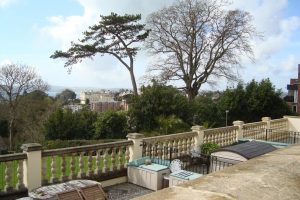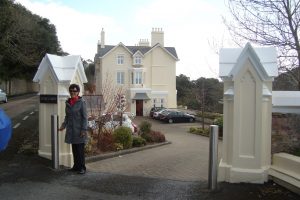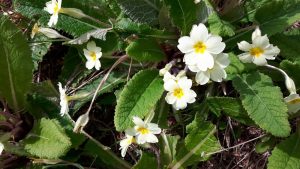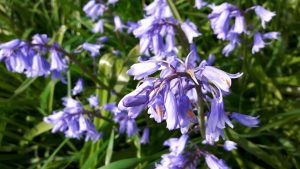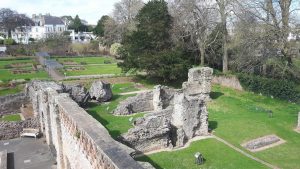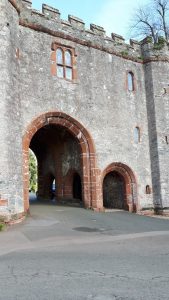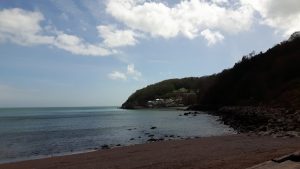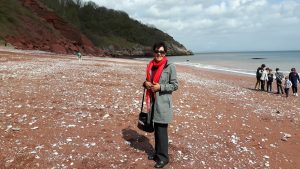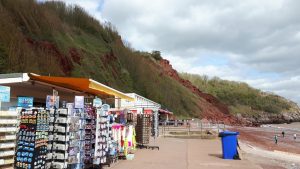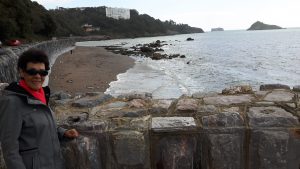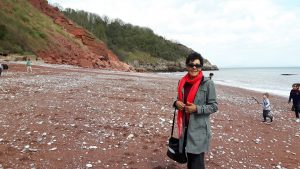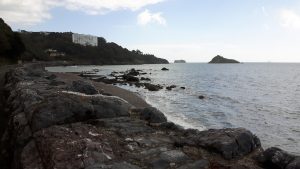Day 8
The weather was still not up to scratch, so Hilary said, ‘Why not take the tour bus around the town. Inquiries made, off we went to wait at the Singing Kettle, a little café up the road. The time ticked on and on-no bus! We asked the people in the café, about the said bus, and they told us it had been and gone! Then someone else advised us we should be waiting further up the road. Hilary, trooper that she is, went to enquire. She came back, shaking her head. We didn’t really have a plan B, but Hilary came up with one on the spot. David and I agreed, and soon we were winding up Torquay’s hilly terrain, heading for Middle Lincombe Road, to find Lyncourt, the house that Hazil and I, along with other children, had been evacuated to during the war.
There it stood, Lyncourt, all decked out in a new coat of pale yellow paint and white trim. The grey walls and purple gables of long ago were gone. We walked down the driveway and stood looking over the terrace, where we could see a blue-gray sea. I pointed out to my friends the approach the German bomber had taken during the war, and how we terrified children had run up the path and into the house. But all is peaceful there now. To the side of the house, there is a flight of steps leading down to Lower Lincombe Road, then on to Manor Gardens, a woodland haven, where we often played.
Back in the car, we drove to the end of the road. I knew there was a manor house but didn’t recall ever going there. What a surprise. It is a residential home for seniors, but the real surprise- it was a castle!
The day remained overcast, but undeterred, we drove down to Meadfoot Beach, where we children had played countless times. Further along the coast, we drove to Babbacombe, another seaside resort with hotels B&Bs and cafes to tempt the palate. We took the railcar down to Oddicombe Beach. By this time, the sun was shining, and people were sitting in their shirt sleeves at the beach café. Mind you, they were at tables in the sun. In shaded areas, coats remained on. It was time for elevenses, and so we indulged ourselves. Children ran and played in the sand. Two little boys tried to outdo each other by bouncing stones on the incoming waves.
Refreshments finished, we strolled down to the edge of the water and snapped more pictures. Hilary and I were scanning the ocean and enjoying the fresh air when suddenly a rogue wave came sweeping up and doused our feet with seawater. Laughing and trying to escape, Hilary fell on to her knees but determinedly kept her camera above her head. Hurray, all the photos remained intact.
A few more photos and we made our way back to the railcar. David drove us to the hotel, where he chose to take a break, and Hilary and I walked through Torre Abbey Gardens up to the ruins of Torre Abbey.
The story of Torre Abbey began on March 25th 1196 with the arrival of an abbot and six canons at Torre (the area from which the later names of Torquay and Torbay are derived). They had been sent from Welbeck Abbey in Nottinghamshire, following a gift of land from the lord of the manor of Torre, William Brewer. Rich fertile land, proximity to the sea and stone from a nearby headland provided the founding medieval monks with all the resources they needed to establish Torre Abbey.
Today established as a museum you can learn about these early years and also about the interesting Georgian Cary Family who resided in the Abbey for hundreds of years. This fascinating family invited Horatio Nelson for a dinner party and this is recreated in the Dining Room through digital talking dinner plates.
…With over 600 incredible works of art from the 18th century to the present day, the Abbey’s collection includes Pre-Raphaelite works including Holman Hunt’s ‘The Children’s Holiday’ and Burne-Jones’ drawings for ‘The Planets’.
Highlights are the watercolours by Thomas Luny and FJ Widgery and a rare proof set of William Blake’s ‘The Book of Job’. Source: Torre Abbey Website

